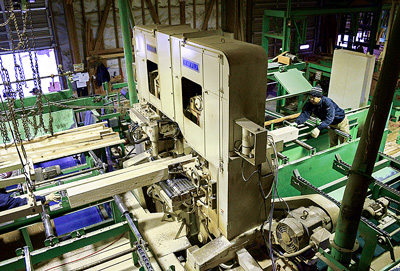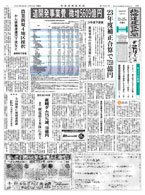Sudden spike in demand for lumber products other than structural materials.
How is the wood shock affecting Hokkaido’s lumber industry? Most Hokkaido lumber is processed into industrial materials such as cushioning materials, pallet materials and lumber products other than structural materials. Although there may seem to be little relation to the shortage of foreign lumber in the housing industry, lumber companies in Hokkaido are also feeling the change.
Seki Wood Industry Co., Ltd. (Headquarters: Shintoku), which mainly manufactures packaging materials and pallet materials, has received seven or eight inquiries since January from vendors with whom they had never done business. President Yukari Yamauchi said, “It’s unusual because we normally deal with long-time customers and rarely have new customers.”
The company is known for being the first company in Japan to establish a domestic two-by-four factory using thinned Todo fir produced in Hokkaido and receives inquiries about the two-by-four method every time the price of imported lumber rises. However, what is different under this wood shock is the demand for materials other than lumber for the two-by-four method.
Demand for industrial materials, which had been declining due to the impact of the COVID-19 pandemic, is gradually recovering. However, in Hokkaido’s lumber industry, which primarily consists of small- and medium-sized companies, the supply of raw lumber is limited, and companies are busy dealing with existing customers. Toshihiro Uchida, Vice Chairman of the Hokkaido Federation of Wood Industry Cooperative Associations, points out, “The wood shock has led to a rapidly emerging need for lumber products other than structural materials, especially from the Tokyo area.”

Photo: Taking advantage of this wood shock as an opportunity, the true value of the sustainable wood industry is being put to the test.
Due to the wood shock, packaging materials have become scarce worldwide. Although attention has begun to shift to lumber produced in Hokkaido, lumber produced there is basically based on direct transactions with customers. Prices are decided based on relationships of trust with customers, which hinders the rise in lumber prices in Hokkaido. Just because there is demand does not mean that lumber industry profits in Hokkaido are increasing.
To begin with, there are various circumstances that led to the current situation in which lumber produced in Hokkaido is primarily used for industrial materials. Outside Hokkaido, there are great environments for growing Japanese cedar and hinoki cypress, and improvements in technology and varieties have progressed through forestation efforts that have continued since the Edo period (1603–1867). Therefore, materials suitable for structural members are self-sufficient to some extent in terms of both quality and quantity.
On the other hand, it is impossible to harvest thick and long lumber from planted forest resources in Hokkaido, most of which are the product of post-war forestation. Although Todo fir planted for use as structural materials is identical to cedar in terms of strength, the technique used to dry it is difficult, and the yield is poor. Japanese larch, which was originally used as piling materials for coal mines, has been used for packing materials and piers because demand for Japanese larch has decreased due to the closure of mines. Against this backdrop, Hokkaido lumber was not often used in construction, thus leading to the introduction of imported lumber.
According to Vice-Chairman Uchida, “Lumber from the United States and Canada, as well as bonded wood from Europe are of excellent quality and inexpensive. It is also common business practice for construction companies to preferentially use foreign lumber.” He also pointed out the issue at hand, saying, “Failure to manage risk by changing this practice is what led to the current situation.”
Goal 12 of the Sustainable Development Goals (SDGs) is “Ensure sustainable consumption and production patterns.” The indicator of the goal includes Domestic Material Consumption (DMC), which shows how many materials are produced in one’s own country or region. Professor Hidehisa Kurotaki of Tokyo University of Agriculture’s Hokkaido-Okhotsk Campus, who is familiar with issues surrounding the forest industry, emphasizes that “using domestic lumber is important in terms of SDGs policy.”
According to Uchida, “Hokkaido must change its system in which almost no structural materials are produced.” He went on to describe his future vision, saying, “I want to create a world where people can make good use of materials produced in their own countries.”
Forests have enriched human life as a recyclable resource since ancient times. The wood shock might be an opportunity for us to reconsider our ideals for lumber and the lumber industry.
(Excerpt from an article on June 11, 2021)
(This series was written by Takahiro Miyazaki and Riku Takada of the Economy and Industry Division and Miho Abe of the Obihiro Branch Office.)













